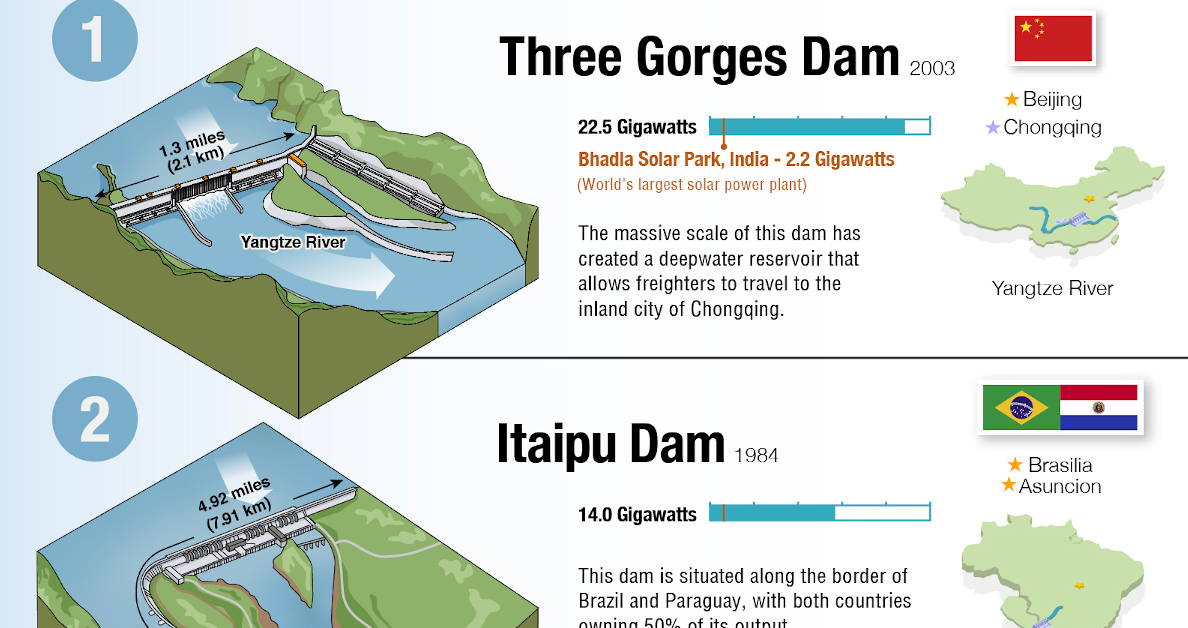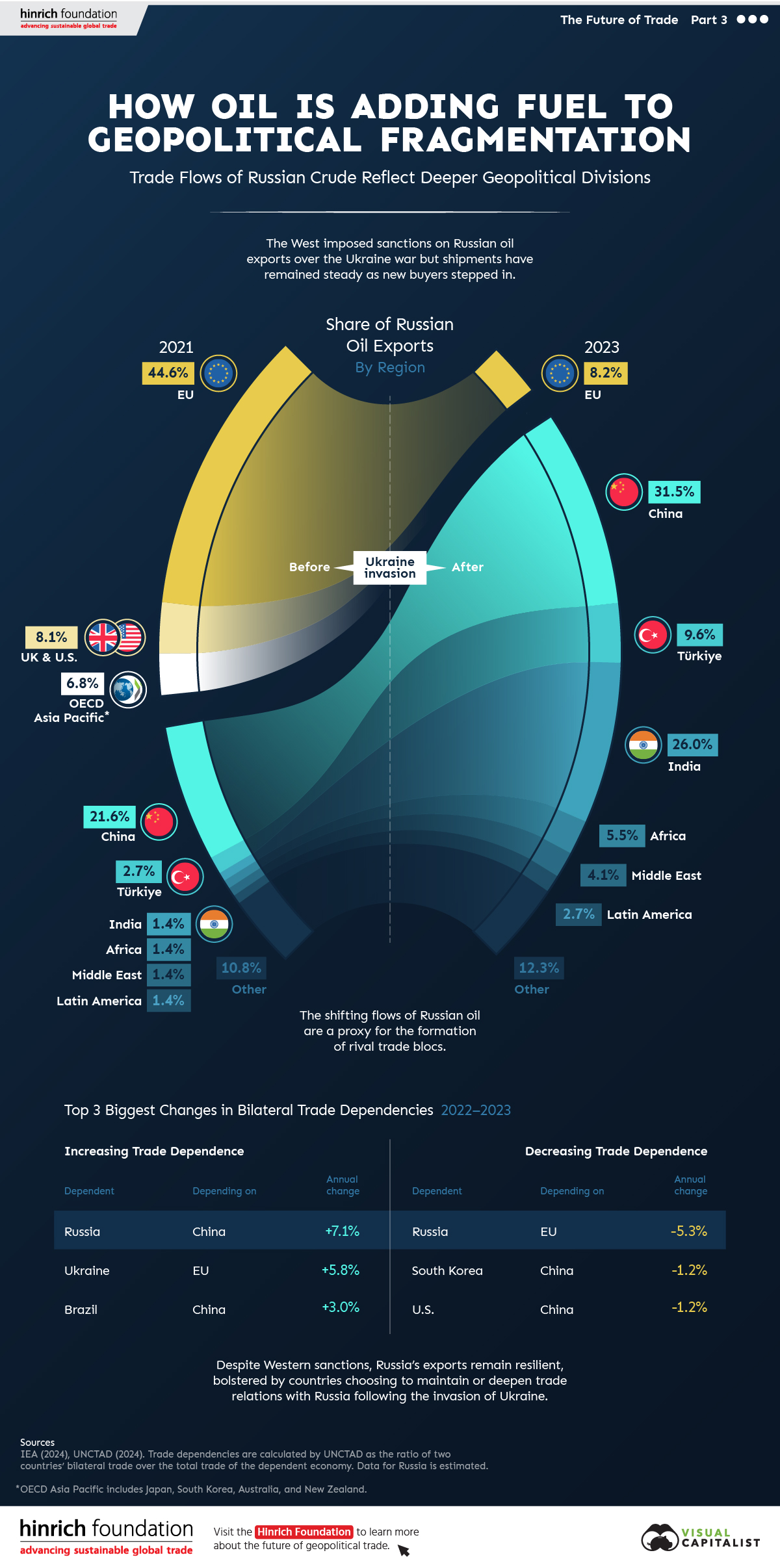Energy
Visualizing the World’s Largest Hydroelectric Dams
![]() Subscribe to the Elements free mailing list for more like this
Subscribe to the Elements free mailing list for more like this
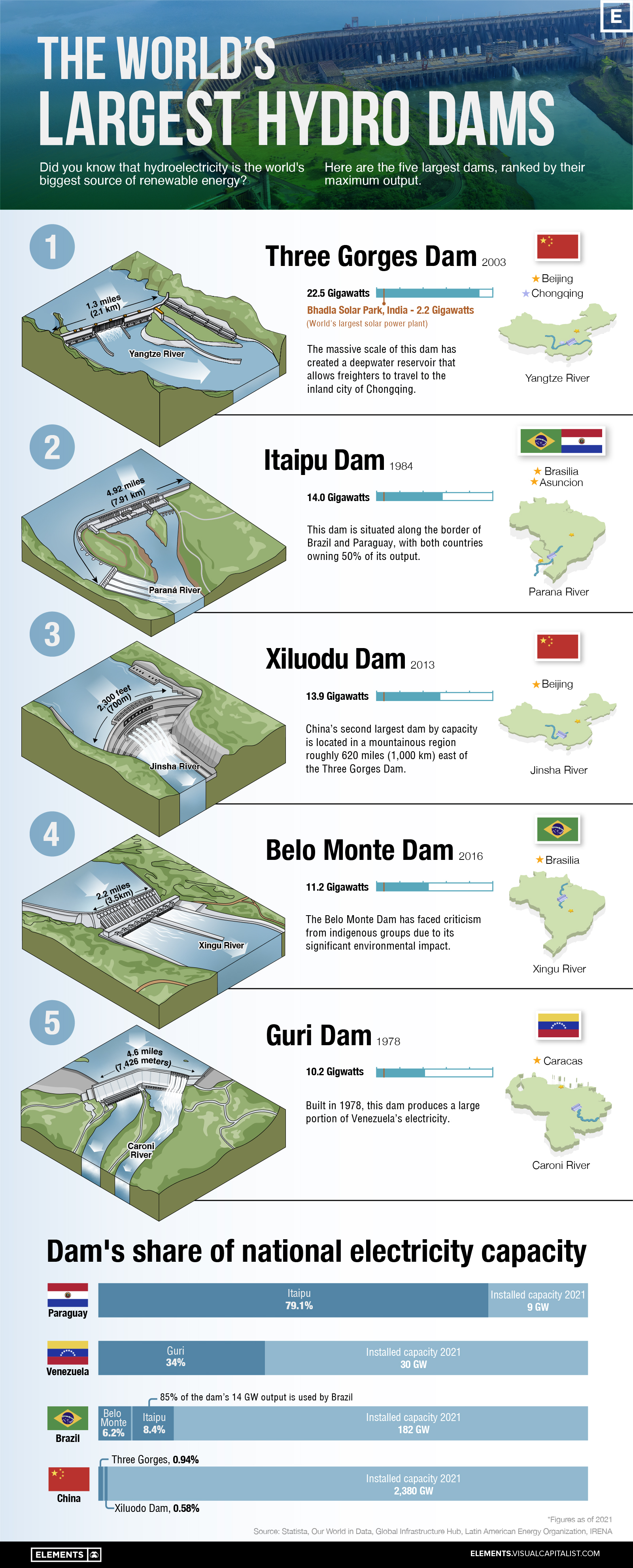
Visualizing the World’s Largest Hydroelectric Dams
This was originally posted on Elements. Sign up to the free mailing list to get beautiful visualizations on natural resource megatrends in your email every week.
Did you know that hydroelectricity is the world’s biggest source of renewable energy? According to recent figures from the International Renewable Energy Agency (IRENA), it represents 40% of total capacity, ahead of solar (28%) and wind (27%).
This type of energy is generated by hydroelectric power stations, which are essentially large dams that use the water flow to spin a turbine. They can also serve secondary functions such as flow monitoring and flood control.
To help you learn more about hydropower, we’ve visualized the five largest hydroelectric dams in the world, ranked by their maximum output.
Overview of the Data
The following table lists key information about the five dams shown in this graphic, as of 2021. Installed capacity is the maximum amount of power that a plant can generate under full load.
| Country | Dam | River | Installed Capacity (gigawatts) | Dimensions (meters) |
|---|---|---|---|---|
| 🇨🇳 China | Three Gorges Dam | Yangtze River | 22.5 | 181 x 2,335 |
| 🇧🇷 Brazil / 🇵🇾 Paraguay | Itaipu Dam | Parana River | 14.0 | 196 x 7,919 |
| 🇨🇳 China | Xiluodu Dam | Jinsha River | 13.9 | 286 x 700 |
| 🇧🇷 Brazil | Belo Monte Dam | Xingu River | 11.2 | 90 X 3,545 |
| 🇻🇪 Venezuela | Guri Dam | Caroni River | 10.2 | 162 x 7,426 |
At the top of the list is China’s Three Gorges Dam, which opened in 2003. It has an installed capacity of 22.5 gigawatts (GW), which is close to double the second-place Itaipu Dam.
In terms of annual output, the Itaipu Dam actually produces about the same amount of electricity. This is because the Parana River has a low seasonal variance, meaning the flow rate changes very little throughout the year. On the other hand, the Yangtze River has a significant drop in flow for several months of the year.
For a point of comparison, here is the installed capacity of the world’s three largest solar power plants, also as of 2021:
- Bhadla Solar Park, India: 2.2 GW
- Hainan Solar Park, China: 2.2 GW
- Pavagada Solar Park, India: 2.1 GW
Compared to our largest dams, solar plants have a much lower installed capacity. However, in terms of cost (cents per kilowatt-hour), the two are actually quite even.
Closer Look: Three Gorges Dam
The Three Gorges Dam is an engineering marvel, costing over $32 billion to construct. To wrap your head around its massive scale, consider the following facts:
- The Three Gorges Reservoir (which feeds the dam) contains 39 trillion kg of water (42 billion tons)
- In terms of area, the reservoir spans 400 square miles (1,045 square km)
- The mass of this reservoir is large enough to slow the Earth’s rotation by 0.06 microseconds
Of course, any man-made structure this large is bound to have a profound impact on the environment. In a 2010 study, it was found that the dam has triggered over 3,000 earthquakes and landslides since 2003.
The Consequences of Hydroelectric Dams
While hydropower can be cost-effective, there are some legitimate concerns about its long-term sustainability.
For starters, hydroelectric dams require large upstream reservoirs to ensure a consistent supply of water. Flooding new areas of land can disrupt wildlife, degrade water quality, and even cause natural disasters like earthquakes.
Dams can also disrupt the natural flow of rivers. Other studies have found that millions of people living downstream from large dams suffer from food insecurity and flooding.
Whereas the benefits have generally been delivered to urban centers or industrial-scale agricultural developments, river-dependent populations located downstream of dams have experienced a difficult upheaval of their livelihoods.
– Richter, B.D. et al. (2010)
Perhaps the greatest risk to hydropower is climate change itself. For example, due to the rising frequency of droughts, hydroelectric dams in places like California are becoming significantly less economical.
Oil and Gas
How Oil Is Adding Fuel to Geopolitical Fragmentation
Which countries and regions decreased, banned, or increased Russian oil imports following the 2022 invasion of Ukraine?

How Oil Is Adding Fuel to Global Fragmentation
Russia’s invasion of Ukraine in February 2022 led to severe bans or restrictions on Russian oil from the West. Meanwhile, other nations—including China, India, and Türkiye—opted to deepen trade ties with the country.
This graphic from the Hinrich Foundation is the final visualization in a three-part series covering the future of trade. It provides visual context to the growing divide among countries shunning Russian oil versus those taking advantage of the excess supply.
Which Countries Have Decreased or Banned Russian Oil Imports?
This analysis uses data from the IEA’s February 2024 Oil Market Report on Russian oil exports from 2021 to 2023.
Following the invasion, both the U.S. and the UK enacted a complete ban on Russian crude. Imports dropped from 600,000 barrels per day (bpd) in 2021 to zero by late-2022.
| Country/Region | 2021 (bpd) | 2022 (bpd) | 2023 (bpd) | Change; 2021-2023 (bpd) |
|---|---|---|---|---|
| EU | 3.3M | 3.0M | 600K | -2.7M |
| UK & U.S. | 600K | 100K | 0 | -600K |
| OECD Asia | 500K | 200K | 0 | -500K |
Similarly, the EU, which has historically been more reliant on oil from Russia, dropped imports by over 80%, from 3.3 million bpd in 2021 to 600,000 bpd in 2023.
OECD Asia-Pacific—which includes Japan, South Korea, Australia, and New Zealand—also slashed their Russian oil imports.
Which Countries Have Increased Imports of Russian Oil?
The pullback in demand for Russian crude from the West created a buying opportunity for countries and regions that chose not to support Western sanctions.
| Country/Region | 2021 (bpd) | 2022 (bpd) | 2023 (bpd) | Change; 2021-2023 (bpd) |
|---|---|---|---|---|
| India | 100K | 900K | 1.9M | +1.8M |
| China | 1.6M | 1.9M | 2.3M | +700K |
| Türkiye | 200K | 400K | 700K | +500K |
| Africa | 100K | 100K | 400K | +300K |
| Middle East | 100K | 200K | 300K | +200K |
| Latin America | 100K | 100K | 200K | +100K |
| Other | 800K | 600K | 900K | +100K |
India increased its imports of oil from Russia, by the largest amount from 2021 to 2023—up to 1.9 million bpd from only 100,000 bpd.
China, the biggest net importer, also saw a large uptick. The country boosted imports for Russian oil by over 40% over this timeframe. Türkiye increased imports of Russian crude by an additional 500,000 bpd.
Several other regions—such as Africa, the Middle East, and Latin America—saw slight upticks in imports.
Shifting Trade Dependencies
The dynamics present in the global crude market underscore broader trends in Russia’s trade relationships. Russia is becoming increasingly less economically reliant on the West and more reliant on China.
From 2022 to 2023, the largest upward shift in the UNCTAD’s bilateral trade dependency estimates was Russia’s increased reliance upon China (+7.1%).
| Dependent | Depending On | Annual Change |
|---|---|---|
| Russia | China | +7.1% |
| Ukraine | EU | +5.8% |
| Brazil | China | +3.0% |
Note: Trade dependencies are calculated by UNCTAD as the ratio of two countries’ bilateral trade over the total trade of the dependent economy.
In fact, China threw a lifeline to Russia in the aftermath of the Ukraine invasion. The Atlantic Council reported that Chinese exports to Russia have grown 121% since 2021, while exports to the rest of the world have increased by only 29% in the same period.
In contrast, Russia also exhibited a large decrease in reliance on the EU (-5.3%). South Korea and the U.S. have made shifts to further distance themselves from China as geopolitical tensions continue to mount.
| Dependent | Depending On | Annual Change |
|---|---|---|
| Russia | EU | -5.3% |
| South Korea | China | -1.2% |
| U.S. | China | -1.2% |
As the Russian oil market shows, geopolitical tensions have the potential to significantly impact trade. Though Russian crude exports remained steady amid the conflict, this necessitated a shift in its main trading partners.

Visit the Hinrich Foundation to learn more about the future of geopolitical trade

-

 Markets2 weeks ago
Markets2 weeks agoComparing Saudi Aramco’s $1.9T Valuation to Its Rivals
See how much larger Saudi Aramco’s market cap is compared to rivals like Chevron, ExxonMobil, and Shell.
-
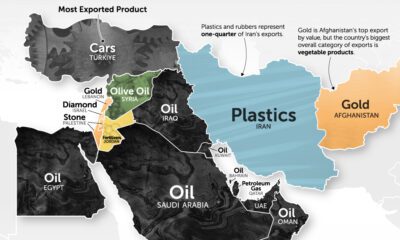
 Energy7 months ago
Energy7 months agoMapped: The Top Middle East Exports by Country
It’s more than just oil. This map of Middle East exports shows the top global product of each country by value.
-
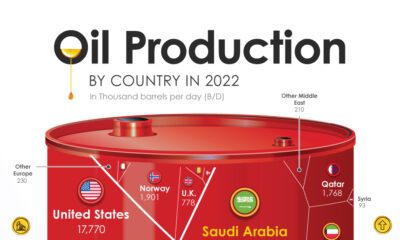
 Countries9 months ago
Countries9 months agoCharted: The World’s Biggest Oil Producers
Just three countries—the U.S., Saudi Arabia and Russia—make up the lion’s share of global oil supply. Here are the biggest oil producers in 2022.
-

 Economy1 year ago
Economy1 year agoPrediction Consensus: What the Experts See Coming in 2023
Using our database of 500+ predictions from reports, articles, interviews, and more, we highlight what experts think will happen in 2023
-
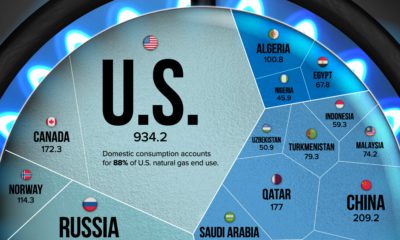
 Oil and Gas2 years ago
Oil and Gas2 years agoWhich Countries Produce the Most Natural Gas?
Natural gas prices have risen since Russia’s invasion of Ukraine. This visualization highlights the world’s largest natural gas producers.
-
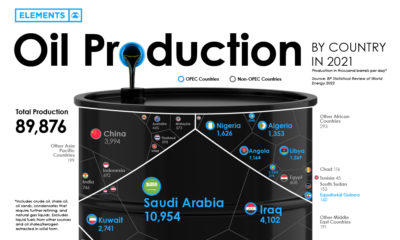
 Oil and Gas2 years ago
Oil and Gas2 years agoVisualizing the World’s Largest Oil Producers
Global oil production averaged 89.8 million barrels of oil per day in 2021. Here are the world’s largest oil producers.
-

 Cryptocurrency6 days ago
Cryptocurrency6 days agoVisualizing the 15 Most Valuable Bitcoin Addresses
-

 Crime2 weeks ago
Crime2 weeks agoVisualizing the Companies Online Scammers Impersonate the Most
-

 Markets2 weeks ago
Markets2 weeks agoComparing Saudi Aramco’s $1.9T Valuation to Its Rivals
-

 Mining2 weeks ago
Mining2 weeks agoVisualizing Cobalt Production by Country in 2023
-
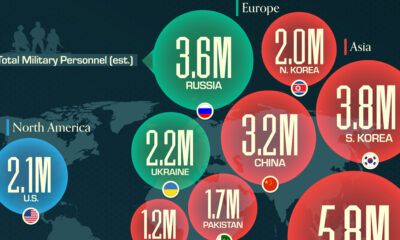
 War2 weeks ago
War2 weeks agoMapped: The World’s Largest Armies in 2024
-

 Demographics1 week ago
Demographics1 week agoCharted: America’s Most Popular Baby Names in 2023
-
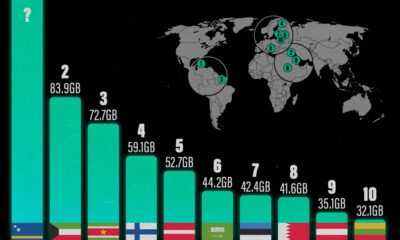
 Technology1 week ago
Technology1 week agoVisualizing the Top Countries, by Mobile Data Usage
-

 Misc1 week ago
Misc1 week agoRanked: Top 10 Deadliest Animals for Humans

